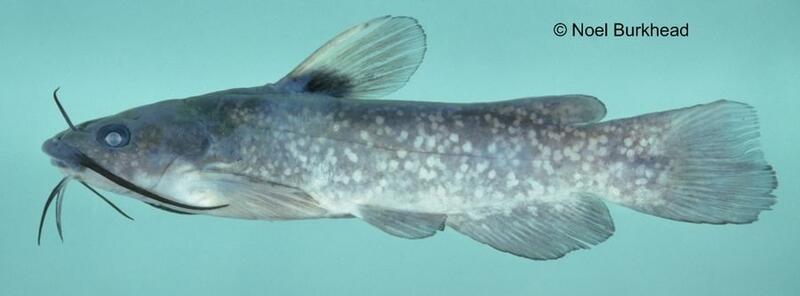







Loading profile. Please wait . . .
Ameiurus serracanthus Yerger and Relyea, 1968
Spotted Bullhead




Federal Protection: No US federal protection
State Protection: Rare
Global Rank: G3
State Rank: S2S3
Element Locations Tracked in Biotics: Yes
SWAP 2015 Species of Greatest Conservation Need (SGCN): Yes
SWAP 2025 Species of Greatest Conservation Need (SGCN): Yes
2025 SGCN Priority Tier: Moderate Conservation Concern
Element Occurrences (EOs) in Georgia: 28
Habitat Summary for element in Georgia: Large streams and rivers with moderate current and rock-sand substrate
The spotted bullhead is a small strikingly marked catfish that attains a maximum total length of 23 cm (9 in). It is a member of a group of bullhead species having a black blotch in the base of the dorsal fin and a relatively large eye. The spotted bullhead is distinguished by profuse, round light-colored spots of pupil-sized diameter on the dark body. The body and fins are suffused with yellow, and the spots thus appear to be yellow. Barbels are dusky to dark. The name serracanthus refers to the strongly serrated pectoral spine which has 6-20 large serrae, or tooth-like projections, on the posterior margin. All the fins are edged in black, and the caudal fin is moderately emarginate.
The spotted bullhead is often confused with the snail bullhead (Ameiurus brunneus); both species have a large eye, dorsal fin blotch, and a mottled coloration pattern. The snail bullhead has much smaller pectoral serrae, lighter colored chin barbels, less distinct spotting, and typically has fewer anal rays (17-20 vs. 19-23) than the spotted bullhead.
The spotted bullhead is known from mainstem and large tributaries. It prefers rocky substrates with moderate currents, and has been collected occasionally over mud near vegetation or other structures such as old stumps in impounded portions of rivers.
No detailed studies of diet and life history have been made. Residents of northern Florida often refer to the spotted bullhead as "snailcat," due to the large quantities of mollusks it consumes. The original description reported four different species of mollusks identified from stomach contents.
Little is known concerning the life history of the spotted bullhead. Gonad development data suggest that spawning may begin in late winter and extend through spring and early summer. Small individuals less than 30 mm (1.2 in) long have been collected from late June through November, suggesting a protracted spawning season.
The spotted bullhead is difficult to collect because of its occurrence in relatively deep, large rivers with structure. Recent samples have been taken using boat electrofishing and gill nets. Trapping and hook-and-line sampling may also be effective.
The spotted bullhead is known from the Coastal Plain province in the Suwannee, Ochlockonee, Apalachicola and St. Andrews Bay drainages in Alabama, Florida and Georgia, associated with the limestone regions of these states. Georgia populations are known from the Apalachicola, Ochlockonee and Suwannee River drainages. Check the [Fishes of Georgia Webpage](http://fishesofgeorgia.uga.edu/index.php?page=speciespages/species_page&key=ameiserr) for a watershed-level distribution map.
Bullhead catfishes are extremely vulnerable to predation by introduced species of large catfishes, such as flathead and blue catfish. Both of these species have been introduced into the Flint and Chattahoochee River systems. Population fragmentation is also a threat, particularly in heavily impounded Chattahoochee River. The removal of dead-head logs would negatively impact the habitats utilized by this species.
| Threat 1 | Threat 2 | Threat 3 | |
|---|---|---|---|
| General Threat | Invasive & other problematic species, genes & diseases | None | None |
| Specific Threat | Invasive non-native/alien species/diseases | None | None |
The spotted bullhead has the smallest range of any bullhead in the world and approximately half of this range occurs within the state of Georgia.
Spotted bullhead populations should be carefully monitored to assess the impact of flathead and blue catfish introductions. Efforts should be made to prevent additional spread of these two non-native species.
Lee, S. L., C. R. Gilbert, C. H. Hocutt, R. E. Jenkins, D. E. McAllister, and J. R.Stauffer. 1980. Atlas of North American fishes. North Carolina State Mus. Nat. Hist. 867pp.
Mettee, M. F., P. E. O'Neil and J. M. Pierson. 1996. Fishes of Alabama and the Mobile Basin. Oxmoor House, Birmingham. 820pp.
Page, L. M. and B. M. Burr. 1991. A field guide to freshwater fishes of North America north of Mexico. Houghton Mifflin, Boston. 432pp.
Yerger, R. W. and K. Relyea. 1968. The flat-headed bullheads (Pisces: Ictaluridae) of the southeastern United States, and a new species of Ictalurus from the Gulf Coast. Copeia 1968: 361-384.
Byron J. Freeman
B. Freeman-Original Account: 1999
K. Owers-Updates: January 23, 2009 Added picture, updated status and ranks, added fish atlas link, converted to new format, minor edits to text B. Albanese—Updates: February 9, 2009 Added similar species, minor text edits.